* * *
 5144. Eupator with Marcus Aurelius,154-170 AD. AV Stater (7.8 gr) Year DXU (464- 167/168 AD).Diademed and draped bust right / Laureate and draped bust of Aurelius, spear before. Anohin 543a. Frolova, vol. I, pg. 296.
5144. Eupator with Marcus Aurelius,154-170 AD. AV Stater (7.8 gr) Year DXU (464- 167/168 AD).Diademed and draped bust right / Laureate and draped bust of Aurelius, spear before. Anohin 543a. Frolova, vol. I, pg. 296.
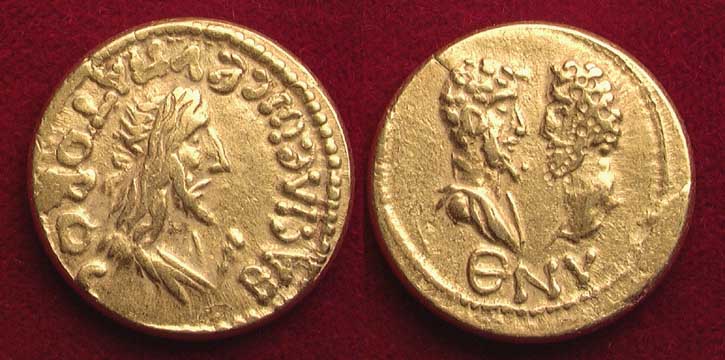 5145. Eupator with Marcus Aurelius and Lucius Verus,154-170 AD. AV Stater (7.71 gr) Year QNU (459- 162/163 AD). Diademed and draped bust right, club before / Bare head and draped bust right of Aurelius vis a vis bare head of Verus. Hair tooled on obverse. Anohin 538. Frolova, vol. I, pg. 292.
5145. Eupator with Marcus Aurelius and Lucius Verus,154-170 AD. AV Stater (7.71 gr) Year QNU (459- 162/163 AD). Diademed and draped bust right, club before / Bare head and draped bust right of Aurelius vis a vis bare head of Verus. Hair tooled on obverse. Anohin 538. Frolova, vol. I, pg. 292.
 5146. Sauromates II with Commodus,174-210 AD. AV Stater (7.0 gr) Year PU (480- 183/184 AD). Diademed and draped bust right / Laureate and draped bust of Commodus right, spear before. Hair tooled on obverse. Anohin 562. Frolova, vol. I, pg. 302.
5146. Sauromates II with Commodus,174-210 AD. AV Stater (7.0 gr) Year PU (480- 183/184 AD). Diademed and draped bust right / Laureate and draped bust of Commodus right, spear before. Hair tooled on obverse. Anohin 562. Frolova, vol. I, pg. 302.
 5147. Kotys II with Hadrian,123-132 AD. AV Stater (7.77 gr) Year KU (420- 123/124 AD). Diademed and draped bust right / Laureate head of Hadrian right. Anohin 471. Frolova, vol. I, pg. 265.
5147. Kotys II with Hadrian,123-132 AD. AV Stater (7.77 gr) Year KU (420- 123/124 AD). Diademed and draped bust right / Laureate head of Hadrian right. Anohin 471. Frolova, vol. I, pg. 265.
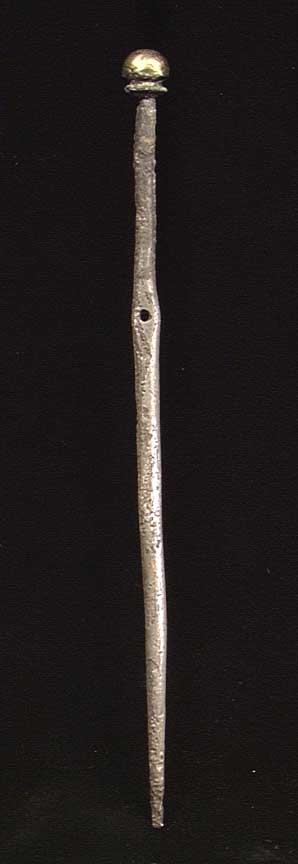 5148. A RARE SYRIAN SILVER CLOAK PIN WITH GILDING. ca. 2nd millennium BC. The cloak pin of solid silver with central attachment hole and knobbed head, the head with much remains of gilding. 5.25 inches. These pins were used to fasten and ornament garments and also doubled as weapons for personal protection. Very rare example as they are nearly always found only in bronze. The intact point not showing in the image. Considerably nicer than image.
5148. A RARE SYRIAN SILVER CLOAK PIN WITH GILDING. ca. 2nd millennium BC. The cloak pin of solid silver with central attachment hole and knobbed head, the head with much remains of gilding. 5.25 inches. These pins were used to fasten and ornament garments and also doubled as weapons for personal protection. Very rare example as they are nearly always found only in bronze. The intact point not showing in the image. Considerably nicer than image.
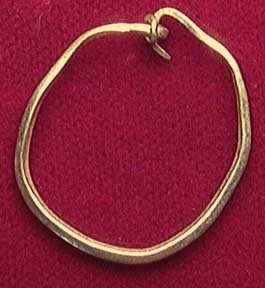 5149. A ROMAN GOLD EARRING, ca. 1st-3rd century AD. Solid high carat gold wire loop with twisted ends. 20 mm. Wearable with care.
5149. A ROMAN GOLD EARRING, ca. 1st-3rd century AD. Solid high carat gold wire loop with twisted ends. 20 mm. Wearable with care.
 5150. Scythian appliqué. IVc. BC. Gold. The appliqué is decorated in relief with a face or mask that appears to be combined with the hand or paw. Two holes (at top and bottom) for attachment. A preference for interlocking forms and for combined motifs that merge with or diverge from each other is typical of Scythian art. For similar iconography see pg. 93 "Melitopolsky Kurgan" by A.I. Terenozgkin & B.N. Mozolevski, Naukova Dumka, 1988. L. 25
mm.
5150. Scythian appliqué. IVc. BC. Gold. The appliqué is decorated in relief with a face or mask that appears to be combined with the hand or paw. Two holes (at top and bottom) for attachment. A preference for interlocking forms and for combined motifs that merge with or diverge from each other is typical of Scythian art. For similar iconography see pg. 93 "Melitopolsky Kurgan" by A.I. Terenozgkin & B.N. Mozolevski, Naukova Dumka, 1988. L. 25
mm.
 5151. Scythian amulet case, IV-III cc. BC, gold. Cylinder with elongate oval cross section. Hollow and permanently closed. Sides decorated with S-shaped round twisted strip cut wires. Beaded wire was applied to outer edges of top and bottom. L. 28 mm, H. 6 mm.
5151. Scythian amulet case, IV-III cc. BC, gold. Cylinder with elongate oval cross section. Hollow and permanently closed. Sides decorated with S-shaped round twisted strip cut wires. Beaded wire was applied to outer edges of top and bottom. L. 28 mm, H. 6 mm.
 5447. A ROMAN GOLD AND GLASS NECKLACE, ca. 2nd-3rd century AD. The necklace consists of hollow gold tubes with blue glass bead spacers, and with two semicircular gold pendants and a central pendant with green glass cabachon. 14.6 inches. Complete.
5447. A ROMAN GOLD AND GLASS NECKLACE, ca. 2nd-3rd century AD. The necklace consists of hollow gold tubes with blue glass bead spacers, and with two semicircular gold pendants and a central pendant with green glass cabachon. 14.6 inches. Complete.
 5152. 4 Roman earrings, II-III cc. AD, gold. Solid tapered wire with a cluster of 4 granules on the bottom. Ref.: "Ancient Greek and Roman jewelry in The Brooklyn Museum" by P. F. Davidson, 1984, cat. # 148,149. L. up to 22 mm.
5152. 4 Roman earrings, II-III cc. AD, gold. Solid tapered wire with a cluster of 4 granules on the bottom. Ref.: "Ancient Greek and Roman jewelry in The Brooklyn Museum" by P. F. Davidson, 1984, cat. # 148,149. L. up to 22 mm.
 5153. 5 Roman earrings, II-III cc. AD, gold. Solid tapered wire turned into a loop at one end; a cluster of 4 granules on the bottom. Ref.: "Ancient Greek and Roman jewelry in The Brooklyn Museum" by P. F. Davidson, 1984, cat. # 148,149. L. up to 25 mm.
5153. 5 Roman earrings, II-III cc. AD, gold. Solid tapered wire turned into a loop at one end; a cluster of 4 granules on the bottom. Ref.: "Ancient Greek and Roman jewelry in The Brooklyn Museum" by P. F. Davidson, 1984, cat. # 148,149. L. up to 25 mm.
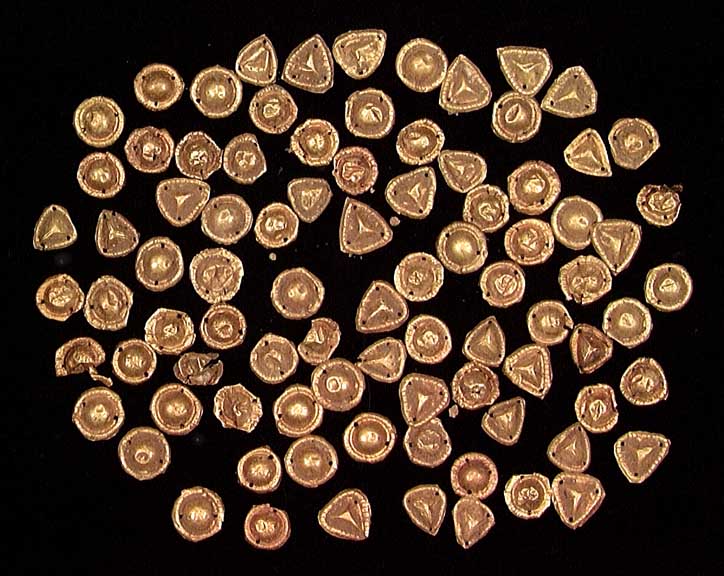 5154. Scythian appliqués, IV-III cc. BC, gold. 27 pyramid and 59 circular- shaped. Done in repousse with high center and beaded border around the perimeter. Up to 3 holes for attachment. Diameters up to 11 mm.
5154. Scythian appliqués, IV-III cc. BC, gold. 27 pyramid and 59 circular- shaped. Done in repousse with high center and beaded border around the perimeter. Up to 3 holes for attachment. Diameters up to 11 mm.
 5155. 12 leaves from a wreath, I c. BC, gold. Celery leaves, basically triangular shape are cut from thin gold sheet. This characteristic form with its pointed, forklike leaf tips becomes the predominant form for the later Hellenistic period, and lasts well into the Roman period. Ref.: "A golden legacy. Ancient jewelry from the B.Y. Berry collection at the Indiana University Art Museum" by W. Rudolph, 1995, cat. #33B. L. up to 30 mm.
5155. 12 leaves from a wreath, I c. BC, gold. Celery leaves, basically triangular shape are cut from thin gold sheet. This characteristic form with its pointed, forklike leaf tips becomes the predominant form for the later Hellenistic period, and lasts well into the Roman period. Ref.: "A golden legacy. Ancient jewelry from the B.Y. Berry collection at the Indiana University Art Museum" by W. Rudolph, 1995, cat. #33B. L. up to 30 mm.
 5156. Hunnish fragmentary diadem, end of IV- beg. of V cc. AD, gold. The fragment is a part of a gold diadem of not constant width with a repousse row of crescent ornament along the edges. In between are cut open squares, grouped by four. Ref.: "Nomadic culture of the south Russian steppelands: the end of IV and V cc. AD" by I. P. Zasetskaia, S.Petersburg, 1994, table 9, 33. L. 95 mm.
5156. Hunnish fragmentary diadem, end of IV- beg. of V cc. AD, gold. The fragment is a part of a gold diadem of not constant width with a repousse row of crescent ornament along the edges. In between are cut open squares, grouped by four. Ref.: "Nomadic culture of the south Russian steppelands: the end of IV and V cc. AD" by I. P. Zasetskaia, S.Petersburg, 1994, table 9, 33. L. 95 mm.
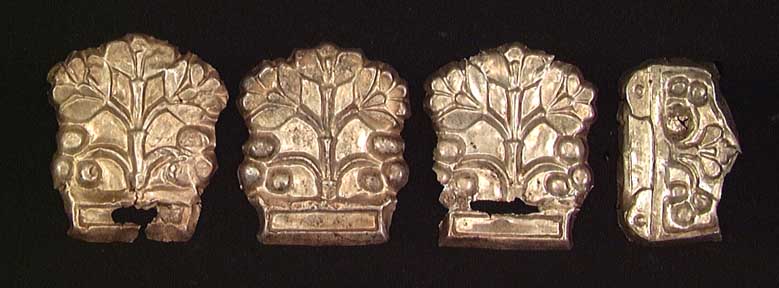 5157. Set of belt ornaments, VII-IX cc. AD, electrum. The set consists of 3 central tabs and 1 terminal tab. They are all done in repousse with the edges bent back. 45 mm x 39 mm x 3 mm. For similar see"Materials in Archeology, History and Ethnography of Tauria", vol. III, p. 373; vol. I, pp. 227-232.
5157. Set of belt ornaments, VII-IX cc. AD, electrum. The set consists of 3 central tabs and 1 terminal tab. They are all done in repousse with the edges bent back. 45 mm x 39 mm x 3 mm. For similar see"Materials in Archeology, History and Ethnography of Tauria", vol. III, p. 373; vol. I, pp. 227-232.
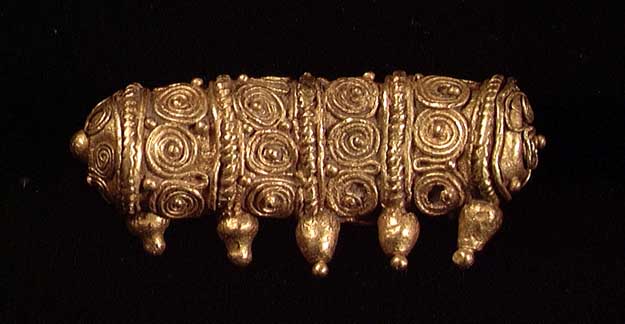 5158. Greek case amulet, third quarter of IV c. BC, gold. The cylinder is divided by bands of two round wires and beaded wire with drop-shape granules attached below; running spiral design with a granule at the center of each coil in between. Terminals are decorated the same way. Ref.: "Treasures from Ukrainian steppes", exhibition catalog, Montreal, 1998, pg. 57. L. 23 mm.
5158. Greek case amulet, third quarter of IV c. BC, gold. The cylinder is divided by bands of two round wires and beaded wire with drop-shape granules attached below; running spiral design with a granule at the center of each coil in between. Terminals are decorated the same way. Ref.: "Treasures from Ukrainian steppes", exhibition catalog, Montreal, 1998, pg. 57. L. 23 mm.
 5159. Roman roundel, I c. BC- I c. AD, gold. Disk shows a seated eagle with his head right in repousse. There is a border of one spool wire and an imitation "braid" of round wires. Two loop attachments are soldered to the back. Ref.: "Ancient Greek and Roman jewelry in The Brooklyn Museum" by P. F. Davidson, 1984, cat. # 235. Greatest dimension 38 mm.
5159. Roman roundel, I c. BC- I c. AD, gold. Disk shows a seated eagle with his head right in repousse. There is a border of one spool wire and an imitation "braid" of round wires. Two loop attachments are soldered to the back. Ref.: "Ancient Greek and Roman jewelry in The Brooklyn Museum" by P. F. Davidson, 1984, cat. # 235. Greatest dimension 38 mm.

>